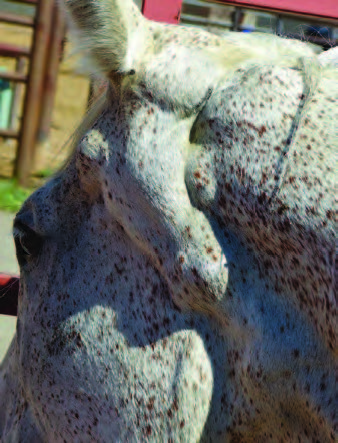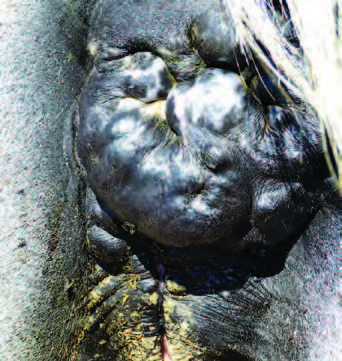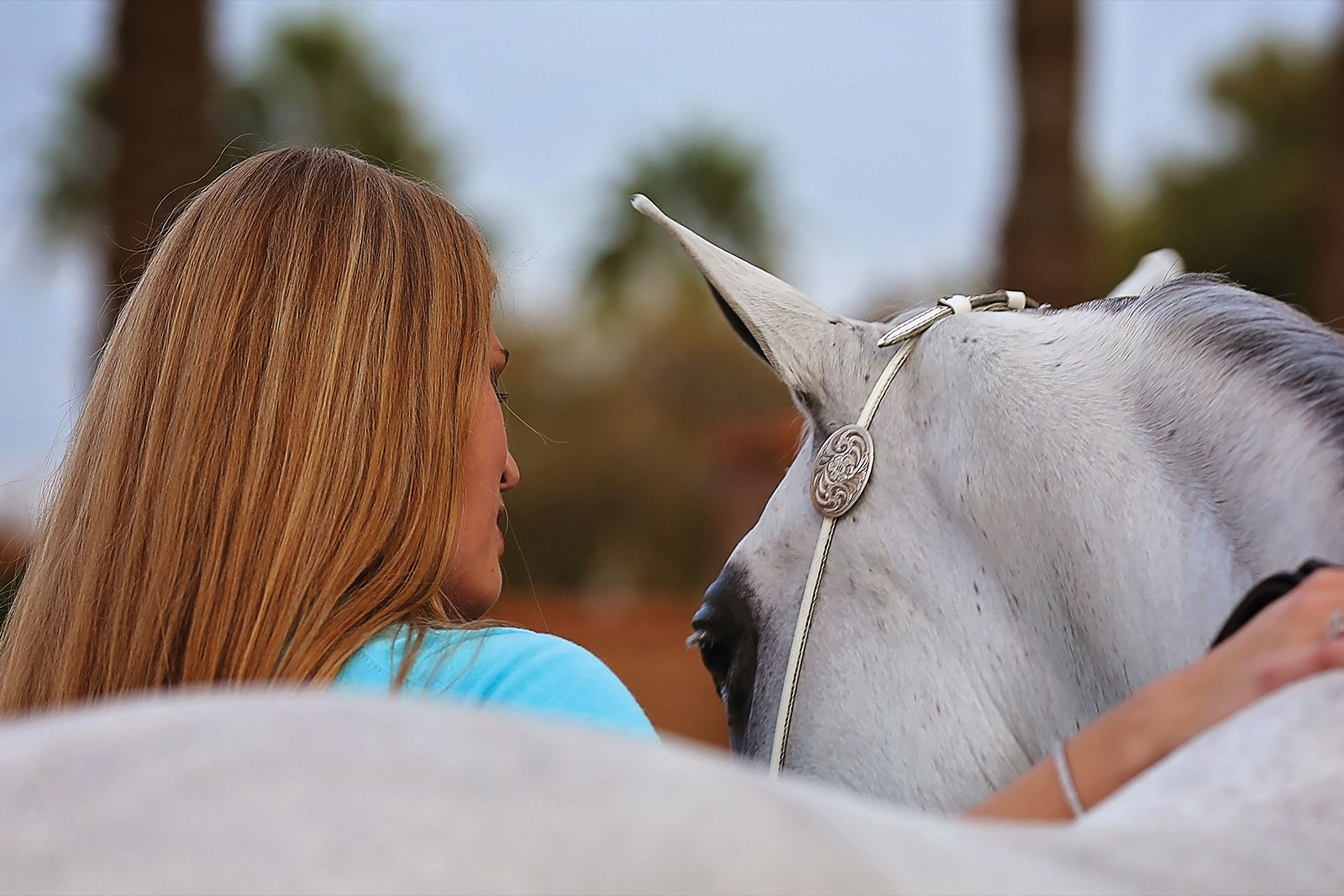By Cindy Reich
As featured in the October 2013 Issue of Arabian Horse World.
The grey Arabian horse galloping over the desert sands is the iconic image of our breed. Grey horses may represent a majority of the Arabian population. However, with the grey coat comes a common problem: equine melanoma.
In humans, if the word “melanoma” is mentioned, it is cause for concern. Melanoma means basically “dark tumor” and comes from the Greek “melas,” dark. Melanocytes are the cells that produce melanin, which is responsible for skin color. Melanoma occurs when the melanocytes grow out of control. This may happen in one of two ways — from a genetic mutation that causes a person to be more susceptible to melanoma or damage to the DNA of the melanocytes caused by ultraviolet radiation. In humans, malignant melanoma is the most common form of skin cancer, and in advanced stages has a high fatality rate.
In grey horses, melanoma has characteristically been considered a rather benign problem in older grey horses — unless it grows rapidly. The most common statistic quoted in articles on melanoma in the horse is that 80 percent of grey horses will have melanoma somewhere in their body by the age of 15. In one study, the youngest horse was six months of age and the oldest was 30. The most common place for melanoma to occur is under the tail and in the perineal area. However, melanoma can occur anywhere there are melanocytes and can include the salivary glands and intestinal lining. Yet melanoma in horses is more often thought of in terms of external tumors when in fact, the horse could also have internal tumors that go undiagnosed.
In grey horses, a mutation of the melanocytes causes the cells to grow uncontrollably, but veterinarians do not know what causes the cells to mutate. Ultraviolet radiation does not appear to cause melanoma in horses as it does in humans. The prevailing opinion for nearly one hundred years was that melanoma in these animals was not of great concern. I can remember being told by our veterinarian that it was likely our affected horse would probably die of old age or some other ailment before dying from melanoma. Even in a quick Internet search, there were many sites that echoed this same “benign” opinion. It is possible that this way of thinking developed because the tumors usually developed later in life in grey horses and often they did die of something else. However, that did not mean that the melanoma was benign. The diagnosis of equine melanoma is often done on visual inspection of the external tumors, but a biopsy is required for a definitive diagnosis.

Melanoma tumors at the base of the ear, paratoid gland.

Facial and head tumors of a horse with melanoma.

Tumors following the lymph and blood system down the neck.
Location of Tumors
Most often the tumors are external and appear on the underside of the tail, around the anus, near the udder (mares) and sheath and penis (stallions). However, the tumors can also be internal, occurring in places such as the lymph nodes, vertebrae, liver, kidney, and abdominal cavity. External tumors, especially those around the anus, can grow so large that they can obstruct the anus and prevent the horse from defecating properly. If the external tumors are abraded or irritated, they can bleed and can also secrete a black, tarry substance. Internal tumors, especially if they rupture, can cause symptoms ranging from colic to neurological signs.
Malignant or Benign?
Part of the confusion in defining equine melanoma is that it shares some characteristics of both benign and malignant tumors. Benign tumors are usually slow growing — and most equine melanomas are slow growing as well. However, the difference is that malignant tumors invade the tissue around them and spread widely. Equine melanoma can do that as well, which should therefore classify them as malignant. What often happens is that the melanomas may not grow or change for years, and then suddenly grow very rapidly. They may spread to other parts of the body — another trait of a malignant tumor. In fact, some researchers think that the dozens of tumors that may make up a large mass around a horse’s anus, for example, may all be different tumors with different rates of mutation.
Dr. John Robertson, director of the Center for Comparative Oncology at the Virginia-Maryland Regional College of Veterinary Medicine, is leading a campaign to have veterinarians recognize all melanoma in the equine as a malignant condition. He contends that even the pea-sized tumor under a horse’s tail is malignant and has the potential to rapidly become grapefruit-sized.
Treatment
In humans, the treatment for early stage malignant melanoma is to cut out the tumor and a lot of the tissue surrounding it. In horses, it was often thought that cutting into or trying to remove melanoma would not result in an improved prognosis and might cause the tumor to spread. Because of that way of thinking, tumors would continue to grow until the mass became so large or inaccessible that surgery was not an option. Which just reinforced the opinion that surgery was not a treatment for equine melanoma. Most veterinarians were simply not anxious to do surgery and adopted a “wait and see” attitude.
However, according to Dr. Robertson, surgery on smaller tumors may be effective as a means of preventing a larger, more inoperable mass from forming. Once the mass becomes large, it is much more difficult to treat.
Several types of drug therapies have been used with varying success. Cisplatin, a chemotherapy drug, was an early treatment for melanoma in horses. It was injected directly into the tumor, but results were mixed. Some veterinarians are now using Cisplatin beads implanted after a tumor has been surgically removed to take care of any residual tumor cells.
Cimetidine, an anti-ulcer medication (Tagamet) has been shown to have some success in reducing the size of tumors, but some horses can develop a resistance to the drug after multiple treatments. Another treatment method uses the horse’s own immune system to fi ght the tumors. A sample of the tumor is taken from the horse, processed, and used to form a “vaccine” that is injected back into the horse. There are also reports of a vaccine used to treat oral melanoma in dogs being used for equine melanoma. (The oral melanoma in dogs is not related to the equine melanoma and is a more aggressive type of tumor. However, the reasoning is that it can slow the growth of the melanoma in dogs and may have the same effect on equine melanoma.)
With the completion of the Horse Genome Project, gene therapy is the wave of the future. A study published in 2001 described utilization of a DNA treatment that included a human cytokine for interleukin-12. This treatment caused regression in 12 out of 12 equine melanoma tumors, with one tumor disappearing completely. Another study published in 2011, reported on injected tumors with interleukin-12 in one group, interleukin-18 in another group, and a placebo in the third group. Both of the interleukin-injected groups showed a regression in tumor size while the placebo group tumors increased in size. Continued research into the use of interleukins to treat melanoma should result in more effective treatment options.
Dr. Robertson has been conducting clinical trials using frankincense oil. The oil is injected directly into the tumors and has shown promise in reducing tumor size. More research is necessary, but according to Dr. Robertson, frankincense has been recognized as a potent medicinal agent for thousands of years.

Characteristic perineal melanoma surrounding the anus.
It is evident that if you have enough grey horses, over time, you will likely have a horse with melanoma. It is important to consider it a malignant condition, regardless of whether the tumors are growing or not. Whether to treat or not will be up to you and your veterinarian. However, the old wait and see attitude is making way for a more proactive approach. Increased interest and research in equine melanoma may provide more effective treatment in the future. Dr. Robertson continues to encourage the veterinary community to reach a consensus on how to classify equine melanoma and to develop a clinical staging protocol for equine melanoma. In time, all these “shades of grey” will result in a diagnosis and treatment that is more black and white.
As I write this, we are in the midst of a flood of truly biblical proportions. Some are calling it a 500-year flood. Reports of horses and other livestock being washed away are hard to hear. Earlier this year the mountains were on fi re — but we have learned to live with fi re. Floods of this magnitude are beyond what anyone can recall in living memory — and no one could prepare for them. Mother Nature will have her way, but at a dear price.






